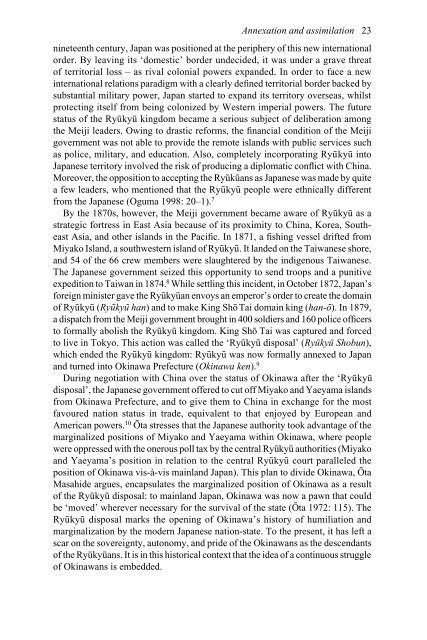Myth, Protest and Struggle in Okinawa
Myth, Protest and Struggle in Okinawa
Myth, Protest and Struggle in Okinawa
Create successful ePaper yourself
Turn your PDF publications into a flip-book with our unique Google optimized e-Paper software.
Annexation <strong>and</strong> assimilation 23<br />
n<strong>in</strong>eteenth century, Japan was positioned at the periphery of this new <strong>in</strong>ternational<br />
order. By leav<strong>in</strong>g its ‘domestic’ border undecided, it was under a grave threat<br />
of territorial loss – as rival colonial powers exp<strong>and</strong>ed. In order to face a new<br />
<strong>in</strong>ternational relations paradigm with a clearly def<strong>in</strong>ed territorial border backed by<br />
substantial military power, Japan started to exp<strong>and</strong> its territory overseas, whilst<br />
protect<strong>in</strong>g itself from be<strong>in</strong>g colonized by Western imperial powers. The future<br />
status of the Ryūkyū k<strong>in</strong>gdom became a serious subject of deliberation among<br />
the Meiji leaders. Ow<strong>in</strong>g to drastic reforms, the f<strong>in</strong>ancial condition of the Meiji<br />
government was not able to provide the remote isl<strong>and</strong>s with public services such<br />
as police, military, <strong>and</strong> education. Also, completely <strong>in</strong>corporat<strong>in</strong>g Ryūkyū <strong>in</strong>to<br />
Japanese territory <strong>in</strong>volved the risk of produc<strong>in</strong>g a diplomatic conflict with Ch<strong>in</strong>a.<br />
Moreover, the opposition to accept<strong>in</strong>g the Ryūkūans as Japanese was made by quite<br />
a few leaders, who mentioned that the Ryūkyū people were ethnically different<br />
from the Japanese (Oguma 1998: 20–1). 7<br />
By the 1870s, however, the Meiji government became aware of Ryūkyū as a<br />
strategic fortress <strong>in</strong> East Asia because of its proximity to Ch<strong>in</strong>a, Korea, Southeast<br />
Asia, <strong>and</strong> other isl<strong>and</strong>s <strong>in</strong> the Pacific. In 1871, a fish<strong>in</strong>g vessel drifted from<br />
Miyako Isl<strong>and</strong>, a southwestern isl<strong>and</strong> of Ryūkyū. It l<strong>and</strong>ed on the Taiwanese shore,<br />
<strong>and</strong> 54 of the 66 crew members were slaughtered by the <strong>in</strong>digenous Taiwanese.<br />
The Japanese government seized this opportunity to send troops <strong>and</strong> a punitive<br />
expedition to Taiwan <strong>in</strong> 1874. 8 While settl<strong>in</strong>g this <strong>in</strong>cident, <strong>in</strong> October 1872, Japan’s<br />
foreign m<strong>in</strong>ister gave the Ryūkyūan envoys an emperor’s order to create the doma<strong>in</strong><br />
of Ryūkyū (Ryūkyū han) <strong>and</strong> to make K<strong>in</strong>g ShōTai doma<strong>in</strong> k<strong>in</strong>g (han-ō). In 1879,<br />
a dispatch from the Meiji government brought <strong>in</strong> 400 soldiers <strong>and</strong> 160 police officers<br />
to formally abolish the Ryūkyū k<strong>in</strong>gdom. K<strong>in</strong>g Shō Tai was captured <strong>and</strong> forced<br />
to live <strong>in</strong> Tokyo. This action was called the ‘Ryūkyū disposal’ (Ryūkyū Shobun),<br />
which ended the Ryūkyū k<strong>in</strong>gdom: Ryūkyū was now formally annexed to Japan<br />
<strong>and</strong> turned <strong>in</strong>to Ok<strong>in</strong>awa Prefecture (Ok<strong>in</strong>awa ken). 9<br />
Dur<strong>in</strong>g negotiation with Ch<strong>in</strong>a over the status of Ok<strong>in</strong>awa after the ‘Ryūkyū<br />
disposal’, the Japanese government offered to cut off Miyako <strong>and</strong> Yaeyama isl<strong>and</strong>s<br />
from Ok<strong>in</strong>awa Prefecture, <strong>and</strong> to give them to Ch<strong>in</strong>a <strong>in</strong> exchange for the most<br />
favoured nation status <strong>in</strong> trade, equivalent to that enjoyed by European <strong>and</strong><br />
American powers. 10 Ōta stresses that the Japanese authority took advantage of the<br />
marg<strong>in</strong>alized positions of Miyako <strong>and</strong> Yaeyama with<strong>in</strong> Ok<strong>in</strong>awa, where people<br />
were oppressed with the onerous poll tax by the central Ryūkyū authorities (Miyako<br />
<strong>and</strong> Yaeyama’s position <strong>in</strong> relation to the central Ryūkyū court paralleled the<br />
position of Ok<strong>in</strong>awa vis-à-vis ma<strong>in</strong>l<strong>and</strong> Japan). This plan to divide Ok<strong>in</strong>awa, Ōta<br />
Masahide argues, encapsulates the marg<strong>in</strong>alized position of Ok<strong>in</strong>awa as a result<br />
of the Ryūkyū disposal: to ma<strong>in</strong>l<strong>and</strong> Japan, Ok<strong>in</strong>awa was now a pawn that could<br />
be ‘moved’ wherever necessary for the survival of the state (Ōta 1972: 115). The<br />
Ryūkyū disposal marks the open<strong>in</strong>g of Ok<strong>in</strong>awa’s history of humiliation <strong>and</strong><br />
marg<strong>in</strong>alization by the modern Japanese nation-state. To the present, it has left a<br />
scar on the sovereignty, autonomy, <strong>and</strong> pride of the Ok<strong>in</strong>awans as the descendants<br />
of the Ryūkyūans. It is <strong>in</strong> this historical context that the idea of a cont<strong>in</strong>uous struggle<br />
of Ok<strong>in</strong>awans is embedded.
















